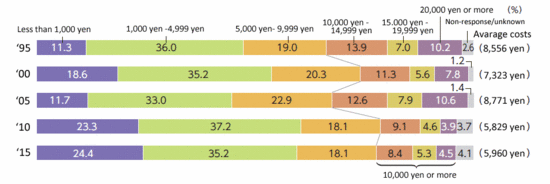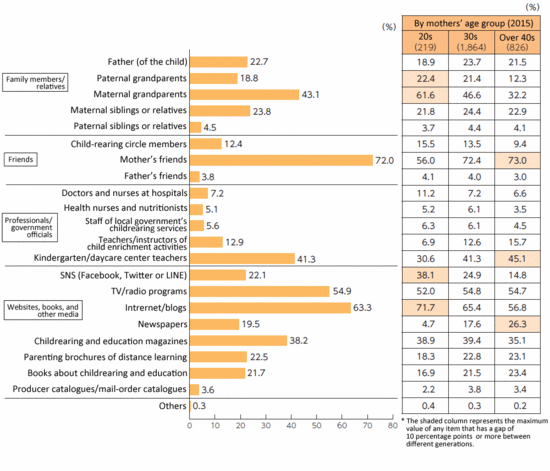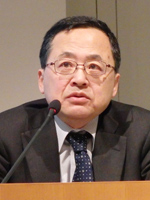What Changes Did Japan's Declining Birthrate Bring about to the Families of Young Children?
- Part 1
- Part 2 (This paper)
4. Widening income inequality
Overall household spending on education for children has been decreasing over the past twenty years (see Figure 4). The spending is made up of fees paid for cram schools, correspondence learning, enrichment lessons, picture books, toys, etc. per month, apart from fees for kindergartens or daycare centers.
Figure 4: Household spending on education per child (changes over the past 20 years)

* Average costs were calculated by replacing the item of "less than 1,000 yen" with 500 yen, "from 1,000 yen up to less than 5,000 yen" with 3,000 yen, and "30,000 yen or more" with 32,500 yen. Those respondents who did not answer or selected "I don't know" are excluded.
* The items of "from 20,000 yen up to less than 25,000 yen", "from 25,000 yen up to less than 30,000 yen" and "30,000 yen or more" were replaced with "20,000 yen or more."
* With respect to the surveys in 1995, 2000 and 2005, the question of "Please tell us your household spending on cram school, correspondence learning, enrichment lessons, picture books, toys, etc. per month, apart from fees for kindergartens and daycare centers (including enrollment subsidies)" was used (provided that the phrases of "(including enrolment subsidies)" and "picture books and toys" were excluded in the 1995 survey).
Source: "Questionnaire on Daily Life of Children in Japan V" by the Benesse Educational Research and Development Institute, 2015
This can be attributed to several factors, one being the lack of growth in household income despite the rise in dual-income families. The results of this survey revealed that the number of families with annual incomes of less than 6 million yen increased from 31.9% in 1995 to 40.8% in 2015. In contrast, the number of families with annual incomes of 8 million yen or more showed a fairly slight decrease, from 31% in 1995 to 26.0% in 2015. Therefore, it can be said that there is a growing gap between the families maintaining the same level of income and those with decreasing income.
Under such circumstances, overall household spending on education has undoubtedly decreased since the 2010 survey and has not recovered. The percentage of families spending less than 1,000 yen on education per month increased, from 11.3% in 1995 to 24.4% in 2015. In contrast, the percentage of families spending 10,000 yen or more per month decreased, from 31.1% in 1995 to 18.2% in 2015. There are certain families maintaining the same level of spending. Therefore, it can be said that there is also a gap between those families capable of spending money on education for children and those less capable of spending.
This may be attributed to several factors, not least of these being higher childcare service fees. In particular, kindergarten involves various costs such as educational material expenses, in addition to the childcare fee. It is assumed that families with lower income cannot afford to pay for enrichment activities other than childcare service fees. In fact, there has been an increase in the number of families that barely pay education costs, or close to none.
Widening income inequality has become a major issue in Japanese society. Some insist that children who cannot go to cram schools due to this income inequality will suffer disadvantage in the future. However, I believe that income inequality does not necessarily have a negative effect on a child's development in early childhood. If a child maintains a close and healthy relationship with his/her parents in his/her early childhood, the child will attain a good development regardless of whether he/she can go to cram schools or participate in enrichment activities. In addition, most of the children go to kindergartens/daycare centers where they can receive the right level of learning and stimulation for their development.
5. Diversified perceptions of value
The results of this survey show that mothers have different perceptions of value on childrearing (see Figure 5). For example, we asked mothers to choose from two different childrearing attitudes, "A: I want to focus on both childrearing and my own lifestyle" and "B: I should sacrifice myself for my child." In the 2015 survey, 52.4% of mothers chose option A, while 47.3% of mothers chose option B. Likewise, 50.5% of mothers chose "A: I should be with my child all the time until my child becomes three years old or so," while 49.4% of mothers chose "B: I do not have to be with my child all the time as long as I provide sufficient loving care." The above results show that, without the intention of judging which option is correct, there are two groups, each consisting of almost half of mothers, choosing opposite opinions.
Figure 5: Perspectives of mothers on childrearing (changes over the past 10 years)
* Only the answers of mothers are included.
* Those respondents who did not answer or selected "I don't know" were excluded; therefore, the total of respondents who answered "A" and those who answered "B" does not come to 100%.
* Two options with the change of 10 percentage points or more are extracted from the overall eight options (comparison between the 2005 survey and the 2015 survey).
Source: "Questionnaire on Daily Life of Children in Japan V" by the Benesse Educational Research and Development Institute, 2015
In this survey, mothers were asked to choose either option. However, I assume that many of them could not determine immediately which option was close to their feelings. As well as the level of household income, the differing perceptions of value of mothers will also affect their decision on various matters, such as choosing a kindergarten or daycare center for their child, or choosing to work full-time or part-time, or to be a full-time housewife.
Another noticeable result is the range of information sources for discipline and education. There is a large gap between mothers from different generations (see Figure 6).
Figure 6: Information sources for discipline and education (2015)

* Multiple answers
* Only the answers of mothers (3,287) are included; therefore, the option of "Mother (of the child)" is omitted.
Source: "Questionnaire on Daily Life of Children in Japan V" by the Benesse Educational Research and Development Institute, 2015
For example, 71.7% of mothers in their 20s chose "Internet and blogs," while 73.0% of mothers in their 40s chose "Mother's friends" as the main information source for discipline and education. It is difficult to determine, based on just this survey, whether this result is due to a generation gap or it is a current trend. In my opinion, this is one of the significant changes with the times. In a society with fewer children, mothers may not easily be able to find someone to consult with. Many mothers may be using emails and SNS messages for this purpose, rather than telephone calls. In today's society where considerable amounts of information can be obtained via the Internet, the diversification of perceptions of value will be affected by such sources of information. Nowadays, everyone can equally access various types of information and freely choose someone to communicate with on the Internet. Therefore, it is assumed that mothers will eventually share ideas with others who have the same opinions, and reinforce those ideas on their own.
6. Summary
I have given an overview of changes in the lives of young children over the past twenty years. In sum, children's relationship with friends and the mode of play have changed significantly, while children are now spending longer periods of time with their mothers. In addition, there is a widening degree of income inequality and, on average, more families have decreased levels of income due to changes in economic conditions. This will lead to a further rise in dual-income families as well as in the number of children attending daycare facilities. Under such circumstances, families' behavior will be diversified according to the level of household income. Eventually, the roles of kindergartens, daycare centers, and ECEC centers will become wider and more important.



 Takashi Muto
Takashi Muto










